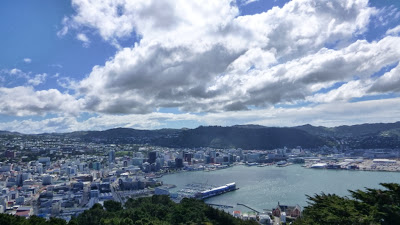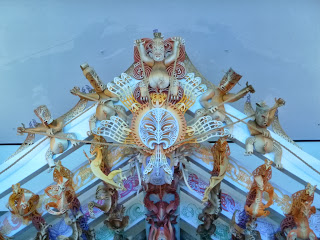Este fin de semana pasado hemos
estado en Wellington, capital de Nueza Zelanda, concretamente en casa de Javi y
Jayde; gaditano él y kiwi ella. Marina y Javi se conocieron gracias a la
afición que comparten de echar un cable a gente que está o tienen la intención
de venir a Nueva Zelanda a través de un grupo de Facebook. Yo he estado mirando
un poco los comentarios de este grupo y, como dice Javi, la gente no tiene dos
dedos de frente así que suerte tienen que gente como él y Marina se pasen por
esos grupos a poner un poco de sentido común.
Javi anda camino de los treinta y
lleva expatriado ya diez años por voluntad propia (no le ha echado ningún
político ni hace vídeos volviendo a Cádiz por sorpresa), el último año y pico
en Wellington. Nos acogió en el piso que comparte con Jayde a cinco minutos
caminando del centro de Wellington, donde hemos estado genial.
Hay que decir que Wellington es
una ciudad muy pequeña por lo que se puede ir caminando a todos lados, si el viento
te deja. Si no estoy equivocado Wellington tiene el honor de ser la capital de
país más ventosa del mundo. Nosotros tuvimos una suerte enorme con el tiempo,
hasta el último día que tuvimos vientos de hasta 140 km/h según el servicio de
meteorología del gobierno (el mejor del mundo según un reportaje que vimos la
semana pasada, en la televisión pública).
El piso de Javi está en un
noveno, donde el aire soplaba tan fuerte que hacía balancearse al edificio
entero. Increíble. Y mareante, así que nos bajamos a la calle a hacer un poco
el tonto, que vientos así no se sufren a diario (si no eres de Wellington,
claro). Como dato curioso deciros que en Wellington nadie tiene paraguas ya que
no duran más de unos segundos antes de desmembrarse en caso de atreverse a abrirlo.
El resto del fin de semana el
tiempo perfecto, sol y calor, que se acerca el verano. Fuimos con Javi y Jayde a
la cima del Mount Victoria, en el extremo suroeste de Wellington (a veinte
minutos del centro caminado) donde, vistas a parte, nos encontramos al famoso
gusano gigante de la zona; bicho que puede llegar a medir 60 cm y que es la
presa preferida del caracol carnívoro de Nueva Zelanda.
Esto es en serio. En “La historia
interminable” había un caracol de carreras, pues aquí tienen uno carnívoro del
tamaño de un puño que caza gusanos de más de medio metro. Son, con menos
glamur, como guepardo y gacela Thompson. Supongo que no hay documentales de las
cacerías de estos caracoles porque no hay locutor capaz de narrarlas sin
desfallecer. Igual Fidel Castro, habrá que preguntar.
Uno de los principales puntos de
interés de Wellington, aparte de Hobbiton (no fuimos), es el jardín botánico.
El jardín es bonito aunque, al
igual que en las carreteras de por aquí, la señalización es desesperante. Yo me
imagino a una abeja que quiere polinizar una rosa y siguiendo las señales acaba
polinizando una margarita y luego, en la colmena, el resto de abejas pues la
miran mal porque ahora a la miel que les salga tendrán que llamarla milflores.
No me quiero olvidar de mi
pequeño tesoro: el jardín botánico de la capital de Nueva Zelanda está en la
calle Salamanca.
Pero esta no es la única
presencia española en la zona. En el frente marítimo nos encontramos con una
placa pagada por la embajada de España que está dedicada a los neozelandeses
que lucharon en defensa de la libertad en la Guerra Civil. No dicen si lucharon
con éxito así que no sabemos a la libertad de quién se refieren. Casi que mejor
así.
Lo más interesante, de todas
maneras, ha sido el museo Te Papa, de entrada libre, como a nosotros nos gusta.
Tiene exposiciones permanentes sobre cultura maorí, sobre la inmigración
europea (en Te Reo a los europeos se nos conoce como paheka) y sobre la
historia natural de la fauna local, tanto terrestre como marina.
Tienen una zona enorme dedicada a
los animales que te puedes encontrar en las costas de Nueva Zelanda. Hay 40
esqueletos completos de diferentes cetáceos (una orca, una ballena azul de 25
m, leones marinos…), un cráneo de cachalote y un calamar gigante de más de 12 metros conservado en formol.
Muy interesante todo. Ahora
estamos en la isla sur, en Tasman, pero esto ya os lo contaremos en otra
actualización. Aquí os dejamos otro pedacito de folklore maorí.
Cuando Maui y sus hermanos detuvieron al Sol
Estaba Maui dormitando en su casa
cuando escuchó a sus hermanos quejándose de la escasa duración de los días.
¡Sólo tenían tiempo de trabajar! Tama Nui Te Ra, el dios Sol, salía por las
mañanas y avanzaba veloz por el firmamento hasta alcanzar el otro extremo del
mundo en poco tiempo.
Maui, cansado de las quejas, les
dijo que le siguieran, que iban a capturar al Sol. Los hermanos aceptaron de
mala gana ya que veían imposible la empresa. Maui les hizo tejer cuerdas con
unas plantas de la zona (Flexes en inglés) y esperaron al Sol justo en el
extremo este del mundo. Cuando el Sol fue a empezar su recorrido por el cielo,
Maui y sus hermanos lo atraparon con sus cuerdas, que aguantaron sin arder el
tiempo justo para que Maui pudiera romperle las rodillas con el hueso mágico de
la mandíbula de su abuelo.
Desde ese día Tama Nui Te Ra, el
dios Sol, está tullido y avanza lentamente en su recorrido por el firmamento,
haciendo que los días sean más largos.
Enrique & Marina
This weekend we’ve been in
Wellington, the capital of New Zealand. Particularly, we’ve been at Javi and
Jayde’s place, he’s gaditano (from Cadiz, Spain) and she’s kiwi. Javi and I
(Marina) met on Facebook via one of the numerous groups of Spaniards living or
travelling or doing something in New Zealand.
Some of this people are really really lost, but they’re lucky enough to
have people like Javi to bring some common sense to the conversations.
Javi’s heading his 30’s but he’s
been living abroad for more than 10 years (because he likes travelling and
moving around the world!) and he’s spent the last one in Wellington. He kindly
hosted us in the cute apartment he shares with Jayde, his girlfriend. The flat
is just five minutes’ walk from the city centre and we’ve felt great.
Wellington is not too big (if you
don’t count the suburbs where there’s not much to see, of course). You can
actually go walking everywhere as long as the wind behaves. If I am not
mistaken, Wellington has the honor of being the world’s windiest capital city.
We were really lucky with the weather except from the last day (Monday) when we
faced 140 km/h winds according to the Metservice of New Zealand (apparently the
most reliable one).
Javi and Jayde’s apartment is in
a 9th floor where the winds were blowing so strongly that the whole
building was moving. Unbelievable. And dizzy, so we decided to go down the
streets to make the fool, because we cannot feel winds like those every day. By
the way, I’ll give you an interesting fact: no one owns umbrellas in Wellington
because these things won’t last longer than two seconds if someone is brave
enough to open them.
But, a part from this day, the
weather of the weekend has been spectacular: shinning sun and warm temperatures,
we’re heading summer! We climbed the Mount Victoria with Javi and Jayde. The
mountain is at the southeast end of the city (about twenty minutes walking from
the city centre) and the views of the city and the ocean were amazing. On our
way up, Enrique found one of those famous giant worms of the area which can be
up to 60 cm long and are the favorite lunch of the carnivorous snail of New
Zealand.
That’s serious. In the
“Never-ending Story” there was a racing snail, well in Aotearoa we’ve got a
snail that eats meat, is as big as a fist and hunts half-a-meter long worms. In
a less stylish way, they’re a duo like cheetahs and Thompson gazelles. However,
I don’t think there are any documentaries about snails hunting worms because
I’m pretty sure there’s no speaker able to narrate their wild encounters and
not falling asleep while doing so. Maybe Fidel Castro could, should ask.
One of the best attractions of
Wellington (a part from Hobbiton where we didn’t go) is its great botanical
garden.
The gardens are beautiful but, as
the roads here, the direction signals are just terrible. I can imagine a bee
wanting to pollinize a rose, and then it follows the signs and ends up
pollinizing a daisy. Later in the beehive all the other bees will look at this
bee with a regretful look because now their honey will just get the millefiori
category.
Anyway, Enrique found his little
present: the botanical garden is located in Salamanca Street which is the city
of Spain where his mum was born and where his grandparents still live.
Furthermore, that wasn’t the only Spanish legacy
in the capital city. In the waterfront, we found a screen of the Spanish
Embassy honouring all the Kiwis who fought in the Spanish Civil War (1936-1939)
literally “in defence of the liberty”. The screen doesn’t say if they succeeded
or not, so we still don’t know which side they’re talking about. Never mind,
it’s better not to know it.
But our favorite place has been
the Te Papa museum, with free entry as we like it. It hosts exhibitions about
Maori culture, migration movements to New Zealand and local geology, biology
and natural sciences.
They’ve got a huge pavilion about
the fauna you can find in the coasts of Aotearoa. There’re 40 complete
skeletons of different marine mammals (a killer whale, a 25-meters-long blue
whale, sea lions, etc.), a skull of a sperm whale and a 12-meters-long giant
squid preserved in formalin.
Everything was really interesting. Now, we’re
in Tasman, in the North of the South Island, but we’ll tell you about
this on our next update. Meanwhile, here is a new little bit of Maori culture.
When Maui and his brothers caught the Sun
Maui was half asleep at home when he heard one
of this brothers complaining about how short the days were. They only had time
to work! Tama Nui Te Ra, the God Sun, came out in the mornings and quickly run
all his way through the sky reaching the other side of the world in a short
time.
Maui, sick of listening to these
complaints, told his brothers to follow him, that they’ll catch the Sun. They
all accepted although they found that was going to be an unreachable challenge.
Maui ordered them to weave some ropes with flexes and waited for the Sun in the
east side of the world. When the Sun started his daily movement, Maui and his
brothers trapped him with the ropes. This ropes resisted the heat of the Sun
just enough time for Maui to break the God’s knees using the magic jaw bone of
his grandfather.
Since that day, Tama Nui Te Ra,
the God Sun, walks slowly and cripple on his way through the sky to the West,
making days longer.
Enrique & Marina













No hay comentarios:
Publicar un comentario